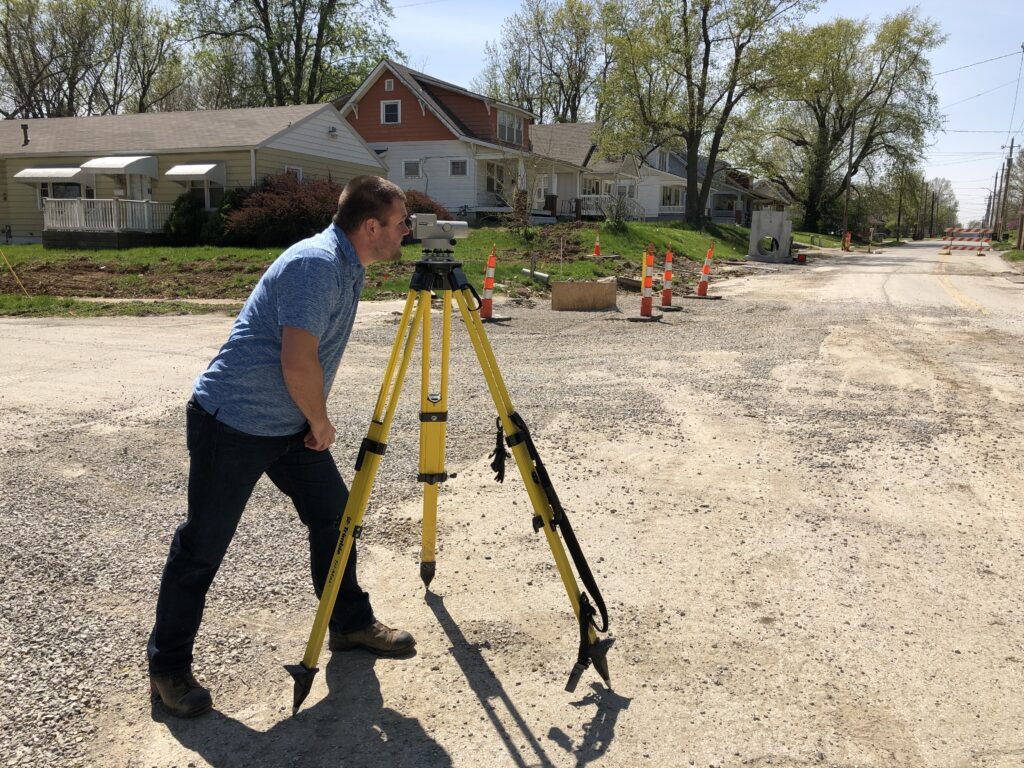5 Reasons Why Surveys are Critical in Land Development

Laying the Foundation
Surveys are the basis of every engineering design, no matter the client, size, or scope of the project. This initial mapping is the foundation upon which every engineering design rests. Surveys establish overall project control, boundaries, and provide site detail and topography, allowing regulatory compliance to be determined. The data from surveys helps to guide the entire land development process. Without accurate surveys, engineering designs would be mere shots in the dark, lacking the precision and reliability needed to create safe, efficient, and sustainable communities compliant with local requirements.
Boundary Identification
Establishing the boundary is the first and most fundamental step in any land development project, regardless of size or scope. The survey provides clear identification of project site limits, ensuring that development teams and partners know the size of the land they have to work with on a particular design. This clarity provides confidence for the development dealing with adjacent property owners and a basis for compliance with zoning and land use regulations. By clearly monumenting site boundaries, surveys help to avoid ambiguity, possible encroachments and disputes that could dig into the overall project timeline. This first survey is a fundamental step in any development process, providing engineers with critical information to proceed with their design confidently. Confirmation that all development activities will be conducted within a site’s legal limits is key before even beginning the design process.
Topographical Understanding
Surveys map the natural and man-made features of the land, from hills, valleys, rivers, and mountains to utilities and existing structures. This comprehensive mapping is vital for planning the placement of buildings, roads, and other infrastructure. It encourages designing a site that works harmoniously with the natural landscape. This essential information allows engineers and developers to understand the terrain and its characteristics more clearly before beginning their design. By offering a clear picture of the site’s topography and detail, these surveys enable engineers to make informed decisions and optimize the use of the land, ensuring that the development is practical and efficient.
Understanding the topography allows for the design of a site that blends seamlessly into the existing landscape. For example, buildings can be positioned to take advantage of natural light and views, roads can be designed to follow the contours of the land, and drainage systems can be placed to accommodate upstream and downstream flows. With survey data, engineers can minimize the environmental impact of their projects. This can include reducing the amount of earth that needs to be moved, preserving natural features, and avoiding areas that are prone to erosion or flooding.
Accurate topographical information can also have cost, safety, and future planning implications. Surveys aim to limit unexpected issues impacting construction schedules, as knowing the precise details of the site’s terrain could avoid costly modifications that might arise from unforeseen obstacles. Proper understanding of the site also ensures that the development meets design standards and complies with local regulations. This includes adhering to slope requirements, ensuring proper drainage, and avoiding areas that may be unsuitable for construction. Topographical surveys are not only useful during initial planning and construction, but also for future maintenance and development. They provide a baseline that can be referred to for any future modifications or expansions, ensuring consistency across development practices. This understanding of terrain is crucial for creating well-designed, efficient, and sustainable developments for years to come.
Regulatory compliance
Land development projects are subject to a local, state, and federal regulations designed to ensure that developments are safe, sustainable, and compatible with existing land use policies. Surveys provide the necessary data to ensure compliance with these regulations, covering aspects like zoning, environmental impact, and construction standards. Surveys are often a mandatory step in the process of obtaining the necessary permits and approvals for any development project. This includes building permits, zoning variances, and environmental clearances. Surveys help streamline this process by providing reliable information often required by regulatory entities.
Zoning laws dictate how land can be used in different areas, specifying the types of buildings that can be constructed and their allowable uses. Surveys provide a dependable basis for ensuring that the proposed development conforms to these laws, avoiding legal issues and potential project delays. Many developments must also comply with environmental regulations aimed at protecting natural resources and minimizing ecological impact. Surveys identify critical environmental features such as wetlands, flood zones, and protected habitats, allowing developers to plan accordingly and avoid legal penalties. Building codes set the minimum standards for construction safety, including structural integrity, fire resistance, and accessibility. Surveys provide the detailed site information needed to design and construct buildings and infrastructure that meet these requirements.
Regulatory compliance is an essential aspect of any land development project, and surveys play a pivotal role in providing critical official documents that support proof of compliance with the myriad of regulations. These documents can be presented to regulatory bodies, demonstrating that the project adheres to all applicable laws and standards, facilitating a smoother approval process to get the land development underway. This proactive and essential measure not only protects the developer but also enhances the credibility of the project. These surveys can also be used to communicate with the public and other stakeholders about the project as a whole, outlining its impacts and future benefits. This transparency and communication can build trust and support for the development throughout the community.
Infrastructure Planning
Surveys are also integral in the realm of infrastructure planning; they provide the data necessary to design effective systems that support the development and future use of a given piece of land. Things like water supply, sanitary sewer systems, electrical grids, telecommunications, and road networks are all vital in planning and maintaining efficient communities, and none of them could be designed without first conducting a proper survey. This comprehensive data, including site topography, existing structures, natural features, and underground utilities is critical for the detailed planning of essential infrastructure. With this information, developers ensure that land can accommodate additional buildings, residents, and businesses, providing a solid foundation for the long-term success of any community.
Risk Management
An efficient and thorough land survey is an essential step in any land development, serving as an invaluable asset that should not be overlooked. By identifying potential issues early, such as flood-prone areas, soil instability, or site contamination, surveys save time and money in the long run. This proactive approach allows developers to plan for and mitigate risks before construction begins, avoiding costly delays and modifications. Ultimately, detailed surveys ensure compliance with regulations, enhance the safety and structural integrity of the project, and build confidence among stakeholders, paving the way for successful and sustainable land development.
Success Showcase
Over the years, BHC has tackled a variety of challenging and unique projects that have truly showcased our expertise and commitment to ‘No Problem’ service. From sites with extensive grading requirements and steep elevations to complex zoning work and easements, we’ve navigated it all. Each project has its own set of hurdles, but our dedication to precision and thoroughness ensures that we constantly deliver reliable and actionable data.

Bartle Hall – We provided utility location, surveying and construction staking services for a renovation which included the addition of two 225-foot curved, solid glass entrances on the venue’s north and south sides. The length and curvature of the new entries contributed unique design and surveying challenges to the project. Our team used advanced robotics to establish more than 250 distinct control points for contractors to ensure the correct stationing of each custom-made section of wall.

College Street (Noland Road to Frederick Street) – BHC was selected by the City of Independence to design improvements to College Street. Improvements included a new 30-foot-wide street (back of curb to back of curb), storm sewer, sidewalks, driveways approaches, streetlights, traffic signal, public involvement and waterline replacement. BHC’s survey team provided topography, boundary, and right-of-way-widening services. This project underscores the range of our technical capabilities and our ability to safely manage complex development in active pedestrian environments.

Saint Luke’s Community Hospital – We provided pre-construction ALTA/NSPS and post-construction as-built surveying services. Unlike a traditional land boundary survey, an ALTA/NSPS guarantees compliance with professional standards. The resulting deliverable allows our client to make data-driven decisions about construction needs by identifying easements, encumbrances, access to utilities, and site topography.
Building with Confidence
Land surveys are an indispensable element of any land action, whether it be for development, public works, or utilities projects. Survey data provides precise measurements, a vital part of ensuring regulatory compliance, aids in optimizing planning, and identification of potential risks. By providing critical data and insights, surveys pave the way for the successful completion of projects, transforming visionary designs into reality with accuracy and confidence. Whether it’s establishing boundaries, mapping topography, or ensuring adherence to regulations, surveys are the unsung heroes of the engineering world, enabling developers to build with assurance and foresight. Luckily for our clients, we have expertise in both civil engineering and surveying sectors, with our own knowledgeable crews ready to set engineers up for success. Reach out to one of our experts or stop by ibhc.com/connect to learn more about how a good survey can kickstart your project – from the ground up!
